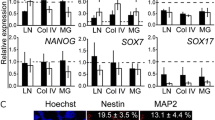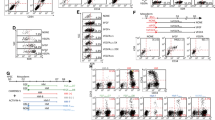Summary
We have previously demonstrated that activin A at low concentrations induced ventral mesoderm including blood-like cells from Xenopus animal caps and that beating heart could be also induced from animal caps treated with 100 ng/ml activin A, suggesting that activin A might be involved in cardiac vasculogenesis. A vascular endothelial growth factor (VEGF) is a powerful mitogen for endothelial cells and is an inducer and regulator of angiogenesis. However, VEGF function in Xenopus development is not clearly identified. In this study, we determined the effect of VEGF on activin A—induced differentiation of animal cap. The VEGF induced duct-like structure composed of Flk-1-positive cells together with the induction of nonvascular tissues, such as neural tissues. This histological result was coincident with our reverse transcriptase-polymerase chain reaction analysis that VEGF together with activin A promoted the expression of Xenopus N-CAM and Xenopus brachyury. This study suggests that VEGF has additional biological activities besides angiogenesis, and arises a different function that VEGF induces stroma cell migration or recruitment that are required for blood vessel formation. This differentiation system will aid in the understanding of angiogenesis during early development.
Similar content being viewed by others
References
Ariizumi, T.; Asashima, M. In vitro induction systems for analyses of amphibian organogenesis and body patterning. Int. J. Dev. Biol. 45:273–279; 2001.
Asashima, M.; Ariizumi, T.; Malacinski, G. M. In vitro control of organogenesis and body patterning by activin during early amphibian development. Comp. Biochem. Physiol. B. Biochem. Mol. Biol. 126:169–178; 2000.
Asashima, M.; Kinoshita, K.; Ariizumi, T.; Malacinski, G. M. Role of activin and other peptide growth factors in body patterning in the early amphibian embryo. Int. Rev. Cytol. 191:1–52; 1999.
Bassez, T.; Paris, J.; Omilli, F.; Dorel, C.; Osborne, H. B. Post-transcriptional regulation of ornithine decarboxylase in Xenopus laevis oocytes. Development 110:955–962; 1990.
Carmeliet, P.; Ferreira, V.; Breier, G., et al. Abnormal blood vessel development and lethality in embryos lacking a single VEGF allele. Nature 380:435–439; 1996.
Chomczynski, P.; Sacchi, N. Single-step method of RNA isolation by acid guanidinium thiocyanate-phenol-chloroform extraction. Anal Biochem. 162:156–159; 1987.
Cleaver, O.; Krieg, P. A. VEGF mediates angioblast migration during development of the dorsal aorta in Xenopus. Development 125:3905–3914; 1998.
Cleaver, O.; Tonissen, K. F.; Saha, M. S.; Krieg, P. A. Neovascularization of the Xenopus embryo. Dev. Dyn. 210:66–77; 1997.
Devic, E.; Paquereau, L.; Vernier, P.; Knibiehler, B.; Audigier, Y. Expression of a new G protein-coupled receptor X-msr is associated with an endothelial lineage in Xenopus laevis. Mech. Dev. 59:129–140; 1996.
Dieffenbach, C. W.; Dveksler, G. S. A Laboratory manual. New York: Cold Spring Harbor Laboratory Press; 1995.
Dumont, D. J.; Fong, G. H.; Puri, M. C.; Gradwohl, G.; Alitalo, K.; Breitman, M. L. Vascularization of the mouse embryo: a study of flk-1, tek, tie, and vascular endothelial growth factor expression during development. Dev. Dyn. 203:80–92; 1995.
Dumont, D. J.; Yamaguchi, T. P.; Conlon, R. A.; Rossant, J.; Breitman, M. L. tek, a novel tyrosine kinase gene located on mouse chromosome 4, is expressed in endothelial cells and their presumptive precursors. Oncogene 7:1471–1480; 1992.
Ferrara, N.; Carver-Moore, K.; Chen, H., et al. Heterozygous embryonic lethality induced by targeted inactivation of the VEGF gene. Nature 380:439–442; 1996.
Ferrara, N.; Chen, H.; Davis-Smyth, T., et al. Vascular endothelial growth factor is essential for corpus luteum angiogenesis. Nat. Med. 4:336–340; 1998.
Flamme, I.; von Reutern, M.; Drexler, H. C.; Syed-Ali, S.; Risau, W. Overexpression of vascular endothelial growth factor in the avian embryo induces hypervascularization and increased vascular permeability without alterations of embryonic pattern formation. Dev. Biol. 171:399–414; 1995.
Fouquet, B.; Weinstein, B. M.; Serluca, F. C.; Oishman, M. C. Vessel patterning in the embryo of the zebrafish: guidance by notochord. Dev. Biol. 183:37–48; 1997.
Fukui, Y.; Furue, M.; Myoishi, Y.; Sato, J. D.; Okamoto, T.; Asashima, M. Nutrition supplemented medium for a long-term culture of Xenopus presumptive ectoderm. Dev. Growth Differ. 45:499–506; 2003.
Furue, M.; Asashima, M. Isolation of pluripotential stem cells from Xenopus embryos. In: Lanza, R., et al. ed. Handbook of stem cells: embryonic stem cells, and adult and fetal stem cells. New York: Academic Press; Vol. 1, 483–492, 2004.
Furue, M.; Myoishi, Y.; Fukui, Y.; Ariizumi, T.; Okamoto, T.; Asashima, M. Activin A induces craniofacial cartilage from undifferentiated Xenopus ectoderm in vitro. Proc. Natl. Acad. Sci. USA 99:15474–15479; 2002.
Harland, R. M. In situ hybridization: an improved whole-mount method for Xenopus embryos. Methods Cell Biol. 36:685–695; 1991.
Iraha, F.; Saito, Y.; Yoshida, K.; Kawakami, M.; Izutsu, Y.; Daar, I. O.; Maeno M. Common and distinct signals specify the distribution of blood and vascular cell lineages in Xenopus laevis embryos. Dev. Growth Differ. 44:395–407; 2002.
Iwama, A.; Hamaguchi, I.; Hashiyama, M.; Murayama, Y.; Yasunaga, K.; Suda, T. Molecular cloning and characterization of mouse TIE and TEK receptor tyrosine kinase genes and their expression in hematopoietic stem cells. Biochem. Biophys. Res. Commun., 195:301–309; 1993.
Mills, K. R.; Kruep, D.; Saha, M. S. Elucidating the origins of the vascular system: a fate map of the vascular endothelial and red blood cell lineages in Xenopus laevis. Dev. Biol. 209:352–368; 1999.
Miyanaga, Y.; Shiurba, R.; Asashima, M. Blood cell induction in Xenopus animal cap explants: effects of fibroblast growth factor, bone morphogenetic proteins, and activin. Dev. Genes Evol. 209:69–76; 1999.
Miyanaga, Y.; Shiurba, R.; Nagata, S.; Pfeiffer, C. J.; Asashima, M. Induction of blood cells in Xenopus embryo explants. Dev. Genes Evol. 207:417–426; 1998.
Ninomiya, H.; Takahashi, S.; Tanegashima, K.; Yokota, C.; Asashima, M. Endoderm differentiation and inductive effect of activin-treated ectoderm in Xenopus. Dev. Growth Differ. 41:391–400; 1999.
Noden, D. M. Embryonic origins and assembly of blood vessels. Am. Rev. Respir. Dis. 140:1097–1103; 1989.
Okabayashi, K.; Asashima, M. Tissue generation from amphibian animal caps. Curr. Opin. genet. Dev. 13:502–507; 2003.
Risau, W.; Flamme, I. Vasculogenesis. Annu. Rev. Cell Dev. Biol. 11:73–91; 1995.
Sasai, Y.; Lu, B.; Piccolo, S.; De Robertis, E. M. Endoderm induction by the organizer-secreted factors chordin and noggin in Xenopus animal caps. EMBO J. 15:4547–4555; 1996.
Sumoy, L.; Keasey, J. B.; Dittman, T. D.; Kimelman, D. A role for notochord in axial vascular development revealed by analysis of phenotype and the expression of VEGR-2 in zebrafish flh and ntl mutant embryos. Mech. Dev. 63:15–27; 1997.
Tamai, K.; Yokota, C.; Ariizumi, T.; Asashima, M. Cytochalasin B inhibitis morphogenetic movement and muscle differentiation of activin-treated ectoderm in Xenopus. Dev. Growth Differ. 41:41–49; 1999.
Tjwa, M.; Luttun, A.; Autiero, M.; Carmeliet, P. VEGF and PIGF: two pleiotropic growth factors with distinct roles in development and homeostasis. Cell Tissue Res. 314:5–14; 2003.
Waltenberger, J.; Mayr, U.; Frank, H.; Hombach, V. Suramin is a potent inhibitor of vascular endothelial growth factor. A contribution to the molecular basis of its antiangiogenic action. J. Mol. Cell Cardiol. 28:1523–1529; 1996.
Yamaguchi, T. P.; Dumont, D. J.; Conlon, R. A.; Breitman, M. L.; Rossant, J. flk-1, an flt-related receptor tyrosine kinase is an early marker for endothelial cell precursors. Development 118:489–498; 1993.
Author information
Authors and Affiliations
Rights and permissions
About this article
Cite this article
Yoshida, S., Furue, M., Nagamine, K. et al. Modulation of activin a—Induced differentiation in vitro by vascular endothelial growth factor in Xenopus presumptive ectodermal cells. In Vitro Cell.Dev.Biol.-Animal 41, 104–110 (2005). https://doi.org/10.1290/040801.1
Received:
Accepted:
Issue Date:
DOI: https://doi.org/10.1290/040801.1




